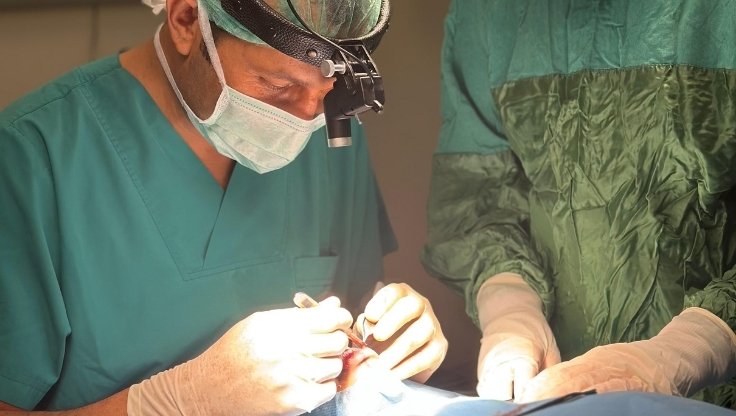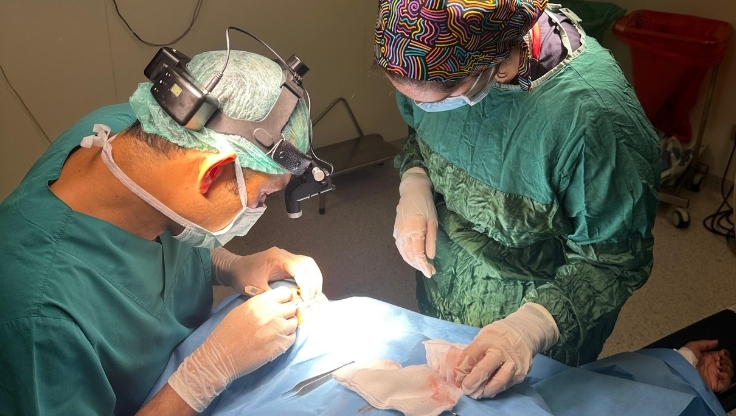
Lip Reduction
Lip reduction is a cosmetic surgical procedure performed when the lips are disproportionately large or protruding in relation to the face. Due to genetic factors, it may be more common in some individuals (e.g., those of African or South Asian descent). In most cases, the lower lip is affected, while in some patients both lips are involved. The goal is to achieve a natural, harmonious lip volume while preserving function.
Procedure Summary
• Anesthesia: Local anesthesia
• Duration: Approximately 30–45 minutes
• Incisions: Inside the lip, along the wet–dry border
• Hospital stay: Not required (same-day discharge)
• Recovery: Swelling/bruising is prominent in the first few days, mostly subsides within 1–4 weeks
• Final result: Takes shape within 4–6 months
Who Is a Candidate?
• Individuals with congenitally/structurally large lips
• Those experiencing difficulty closing the mouth, drooling, or speech discomfort due to lip volume
• Patients seeking a more balanced smile and improved lip–nose–chin proportion
Smokers, patients with active cold sores (herpes), or systemic conditions should undergo preoperative evaluation with their doctor.

How Is the Surgery Performed?
Incisions are planned along the wet–dry line (vermilion–mucosal junction) inside the lip. According to preoperative measurements, an appropriate amount of tissue is removed, the lip contour is reshaped, and closed with fine aesthetic sutures. Since the incisions are inside the mouth, no visible external scars remain. The aim is to reduce volume while preserving natural contour and maintaining oral competence.
Recovery Process
• First days: Swelling and bruising are normal; speech and smiling may be limited.
• Week 1: Swelling decreases significantly; absorbable sutures dissolve spontaneously.
• Weeks 2–4: Lip volume and contour begin to settle; most patients resume social activities.
• 4–6 months: Final shape and softness achieved.
Postoperative Care Tips
• Apply intermittent cold compresses for the first 48–72 hours to reduce swelling.
• Oral hygiene is crucial: Regular rinsing and gargling are recommended.
• Avoid hot food/drinks for 3 days; prefer soft foods.
• Avoid strenuous mouth movements, intense exercise, and sauna/steam rooms during the first week.
• Take prescribed medications regularly and attend follow-up appointments.
Possible Risks and Complications
As with any surgery, rare risks include:
• Bleeding, infection, prolonged swelling
• Asymmetry, irregularities in the lip line
• Temporary numbness/sensory changes
• Difficulty closing the mouth due to excessive tissue removal (minimized with experienced surgical planning)

Lip Lift
The distance between the upper lip and the base of the nose (philtrum) may lengthen with age or be structurally longer than average. This can cause the lips to appear thin and turned inward, while reducing upper teeth visibility when smiling. Lip lift is a surgical procedure that involves precise skin removal beneath the nose to elevate and slightly evert the upper lip. This enhances lip contour, increases the visible “red lip,” and creates a more balanced facial proportion.
Who Is a Candidate?
• Patients with a long upper lip–nose distance
• Those who cannot achieve sufficient red lip show with fillers
• Individuals with inward-rolled lips and limited upper teeth display when smiling
• Patients seeking a more youthful and dynamic lip–nose ratio
The procedure may be postponed in cases of active smoking, wound-healing problems, or active infections.
How Is It Done?
• Technique: In my practice, I use the modified “bullhorn” subnasal lip lift technique.
• Incisions and Scar: Incisions are placed along the natural creases at the base of the nose, hiding the scar.
• Steps: A planned amount of skin is removed based on measurements; the upper lip is lifted and secured with fine aesthetic sutures.
• Anesthesia: Usually performed under local anesthesia.
• Duration: Approximately 30–45 minutes.
• Combinations: Can be combined with facial rejuvenation surgeries; if necessary, may be combined with a corner lip lift.
Recovery and Aftercare
• First 72 hours: Intermittent cold compresses reduce swelling.
• Pain/Swelling: Mild to moderate in the first days; most patients return to light activities the next day.
• Sutures: Typically removed on days 5–7 (depending on suture type).
• Scar Care: After suture removal, silicone gel/strips and SPF 50+ sun protection help scar maturation.
• Social Life: Makeup can camouflage the scar from week 1; scar maturation takes 3–6 months.
Possible Risks
As with all surgical procedures, rare risks include:
• Bleeding, infection, prolonged swelling
• Asymmetry, under/over-correction
• Visible scarring (depending on individual healing)
• Temporary sensory changes
Experienced surgical planning and meticulous suturing techniques minimize these risks.
Lip Lift vs. Lip Fillers
• Lip lift: Shortens upper lip–nose distance, enhances red lip show; structural and permanent effect.
• Filler: Adds volume and defines contour; temporary.
• Combined: In selected patients, a small amount of filler may be used after a lip lift for fine adjustments.
Frequently Asked Questions
The incision in lip lift surgery is hidden within the natural crease at the base of the nose, making the scar generally unnoticeable. With proper scar care, silicone gel, and sun protection, the scar becomes increasingly faint over time.
After surgery, patients may feel tightness in the upper lip and temporary restriction in expressions. This is temporary, and lip functions return to normal within a few days. Smiling and speaking quickly regain their natural appearance.
In lip lift surgery, the removed skin is permanently excised. Although natural aging continues, the shortened lip–nose distance and enhanced red lip show are preserved for many years.
Light walking can be resumed shortly after surgery. However, running, fitness, or strenuous exercise is usually recommended only after the second week, with your doctor’s approval.
About the Author
Prof. Dr. Osman Kelahmetoğlu
Specialist in Plastic, Reconstructive and Aesthetic Surgery
This article was prepared by Prof. Dr. Osman Kelahmetoğlu based on scientific resources and clinical experience. You may contact us for further information or to schedule a consultation.
Contact: iletisim@osmankelahmetoglu.com – 0 (533) 351 76 37
